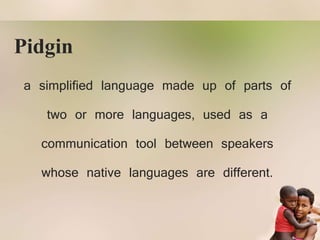
In 1930 he published the RN texts which were known then and which he had used as a basis for the description of 1927. The first linguistic description of RN was published by Olaf Broch in German in 1927 in Archiv für slavishe Philologie and in the same year also in Norwegian, at the request of the editor of the Norwegian philological journal Maal og Minne. The study provides new translations and etymologies for ‘difficult’ CPR words and sentences. non-verbs, final particles), syntax (syntactic roles, sentence and phrase word order, postpositions and prepositions, comparatives), and vocabulary (synonyms, loanwords, structural and semantic calques, ‘diminutive politeness’). The paper discusses all key aspects of CPR: history (both of the pidgin and its study), phonology (segmental inventory, stress, tone), morphology (verbs vs. Some of these sources are rarely accessible to Western linguists. The sources of CPR include: pidgin records and descriptions ‘Russian’ textbooks compiled for the Chinese going to Russia and works of literature depicting contacts between the Russians and indigenous peoples of Siberia, who often spoke a variety of CPR. This paper considers the influence of both ‘parent’ languages at all CPR levels. It also uses a typical inflecting language as its lexifier and an isolating language (Chinese) as its substrate.

Unlike many Western-based pidgins, it was formed in a territory where the lexifying language (Russian) was dominant. The much-understudied Chinese Pidgin Russian (CPR) has existed at the Chinese–Russian border since at least the 18th century. It is argued that there was some transmission of the use of for in these pidgins to the for in creoles. The use of for in the pidgin is compared with similar lexical items in four other pidgins. In this Basque Pidgin, twelve of the fifteen sentences contain the lexical item for in diverse functions. Third, in the current debate on the origin of fu and similar markers as complementizers, many claims have been made. It is suggested that the knowledge of an English Nautical Pidgin played a role in the formation of this pidgin. Second, although the sentences come from a Basque word list compiled by an Icelander, there are also some words from other languages, of which English is the most prominent. First, Basque may throw an interesting light on the pidginization process because it is not an Indo-European language and has several unusual features. These sentences are interesting for several reasons. The paper deals with a Basque Nautical Pidgin from which a number of sentences have been preserved in a seventeenth century Basque-Icelandic word list. The attitudes towards pidgin and creole languages in education, the part of political and linguistic entities in adopting Nigerian Pidgin and Mauritian Kreol as the medium of teaching literacy in their respective countries are the central issues of focus. The central argument is that pidgin and creole languages have the potential to express complex realities and function officially in formal education despite the negative attitudes towards them by their speakers. Pidgins and creoles researchers have labelled pidgin and creole languages as “developing” and they highlight their capacity to perform the same functions as their developed European lexifiers, English and French.

This paper suggests that Pidgin and Creole languages should be elaborated for use as the media of instruction in formal education, particularly in contexts where up to 85 per cent of the population speak them. Using Siegel’s (2008) scale of morphological simplicity, from lexicality to grammaticality, this study concludes that tense/aspect marking is expressed lexically through temporal adverbials or inferred from the context in the earliest stages of Arabic-based pidgins, which only later-in stabilized pidgins-develops into grammaticalized markers when certain criteria are met.Ĭreole and Pidgin languages are spoken by not less than 50 million people around the globe, but literacy is usually acquired in other languages, especially those languages introduced by the former colonial powers.

This study examines tense/aspect marking in five Arabic-based pidgins: Juba Arabic, Turku Pidgin, Pidgin Madame, Romanian Pidgin Arabic, and Gulf Pidgin Arabic. Creole languages, however, are said to develop such categories through grammaticalization. Tense/aspect categories are marked through temporal adverbials or inferred from the context.

Structural relations, therefore, are mostly expressed externally. Summary The earliest stages of pidgin formation show a preference for analytic and morphologically reduced grammatical constructions relative to their lexifier or substrate languages, where the apparent morphological marking, if found, seems to be fossilized.


 0 kommentar(er)
0 kommentar(er)
